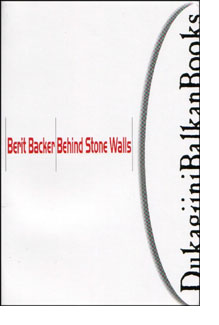|
Robert Elsie
and Antonia Young
Berit Backer. Behind stone walls
Changing household organization among the Albanians of Kosova.
Edited by Robert Elsie and Antonia Young,
with an introduction and photographs by Ann Christine Eek
Dukagjini Balkan Books
ISBN 9951-05-024-7
Dukagjini, Peja 2003
304 pp.

 PREFACE PREFACE
'Behind Stone Walls' is a sociological,
or more specifically, a social anthropological study of traditional
Albanian society. It focusses, in particular, on the formation
and evolution of household and family structures among the Kosova
Albanians and was written on the basis of field work carried
out by the author in the village of Isniq in western Kosova in
1975. The study provides the reader with a fascinating glimpse
into an exotic world which will soon belong to the past, as the
author predicted.
Of all the phenomena which the 'tribal'
society and heroic culture of the Kosova Albanians produced in
the past, few have been regarded as more unusual than the family
structure itself, characterized by a strongly patriarchal hierarchy
and an extended family, with typically up to 50 members living
in one family compound or indeed under one roof. This type of
family structure, known to anthropologists commonly by the Serbian
term 'zadruga,' still occurs in Kosova today, though in a more
sporadic fashion than it did thirty years ago. In the other parts
of the southern Balkans it has long since disappeared.
Up to the 1970s, the Kosova Albanians
lived in relative isolation from the rest of Europe and, despite
the open nature of Yugoslav socialism, their traditional society
had not been affected in any major way by globalization. The
mid-1970s, however, marked a period in which Yugoslav gastarbeiters
in Germany and Switzerland - many Kosova Albanians - were returning
home and bringing back not only money but also new ideas.
The author of this book, the late Norwegian
anthropologist Berit Backer (1947-1993), had the good fortune
of penetrating this very foreign, though European culture just
before the turning point, i.e. before it was subjected to substantial
foreign influence and change. It was a time of relative political
stability and social order in Yugoslavia. After years of oppression
by the Belgrade authorities, the Albanian population of Kosova
had finally been given a modicum of autonomy and official equality
with the other peoples of the Yugoslav federation. This period
was brought to an end by the Albanian uprising of 1981, which
signalled the beginning of the slow and irreversible demise of
Yugoslavia.
'Behind Stone Walls' was first submitted
as a masters thesis to the Institute of Social Anthropology at
the University of Oslo in Norway in April 1979, but was never
made available to the public at large. Berit Backer was a great
friend of the Albanian people and, during the 1980s, became a
leading human rights activist, in particular in defence of the
cause and rights of the Kosova Albanians. Her activities on behalf
of the International Helsinki Federation and her active support
of Kosova Albanian refugees in Norway made it impossible for
her to find time to prepare a definitive form for the publication
of the thesis during her lifetime.
Since her untimely death in Oslo on 7
March 1993, many people have expressed an interest in the publication
of this work. For this reason, the editors agreed to prepare
the present edition even though they were, alas, unable to consult
the author herself. It is possible that, had the project been
discussed with her, the author might have made substantial alterations,
amendments, omissions or additions to the original manuscript.
The present, somewhat revised version omits many of the graphs
and charts of the original thesis as well as much material of
purely economic and statistical concern. Readers particularly
interested in the economic aspects of Kosova village life in
the period are advised to consult the original typescript, of
which a number of copies are in circulation.
'Behind Stone Walls' offers much food
for thought to anyone interested in the structures of traditional
Albanian and Balkan society. It is hoped that through this publication,
marking the tenth anniversary of the author's tragic murder,
the memory of Berit Backer will live on.
Robert Elsie
Olzheim, Germany
Christmas 2002

TABLE OF CONTENTS
- Preface
- Berita - the Norwegian Friend of the Albanians
by Ann Christine Eek
- BEHIND STONE WALLS
Acknowledgement
- INTRODUCTION
Family and household
Family - types, stages, forms
Demographic processes in Isniq
Fieldwork
Data collection
- ISNIQ: A VILLAGE AND ITS FAMILIES
Once upon a time
Going to Isniq
Kosova
First impressions
Education
Sources of income and professions
Traditional adaptation
The household: distribution in space
Household organization
Household structure
Positions in the household
The household as an economic unit
- CONJECTURING ABOUT AN ETHNOGRAPHIC PAST
Ashtu është ligji - such are the rules
The so-called Albanian tribal society
The fis
The bajrak
Economic conditions
Land, labour and surplus in Isniq
The political economy of the patriarchal family or
the patriarchal mode of reproduct
- RELATIONS OF BLOOD, MILK AND PARTY MEMBERSHIP
The traditional social structure: blood
The branch of milk - the female negative of male positive structure
Crossing family boundaries - male and female interaction
Dajet - mother's brother in Kosova
The formal political organization
Pleqësia again
Division of power between partia and pleqësia
The patriarchal triangle
- A LOAF ONCE BROKEN CANNOT BE PUT TOGETHER
The process of the split
Reactions to division in the family
Love and marriage
The phenomenon of Sworn Virgins and the future of sex roles
- Glossary of Albanian terms used in this book
- Bibliography
- Photos
by Ann Christine Eek

|
 PREFACE
PREFACE